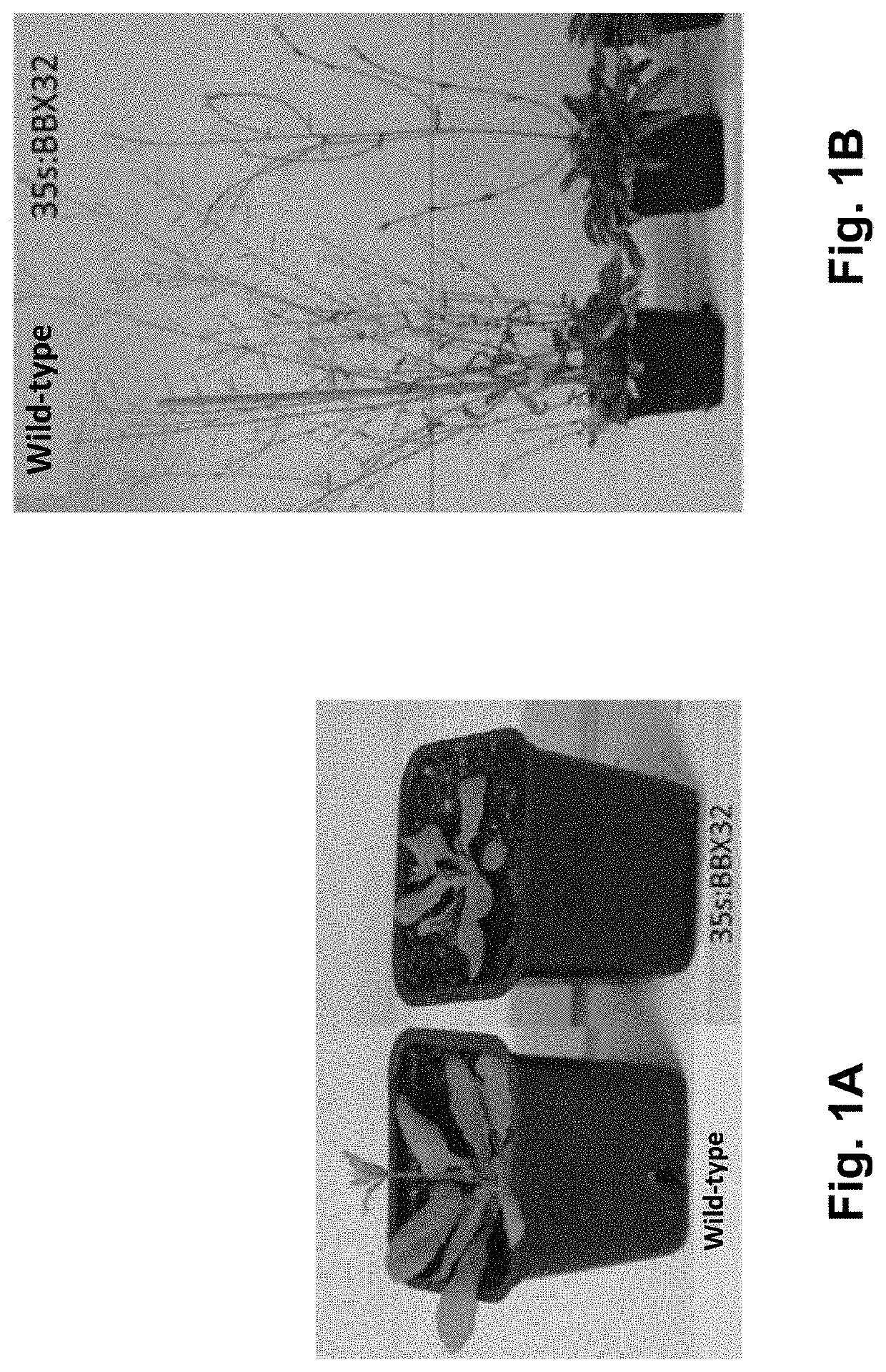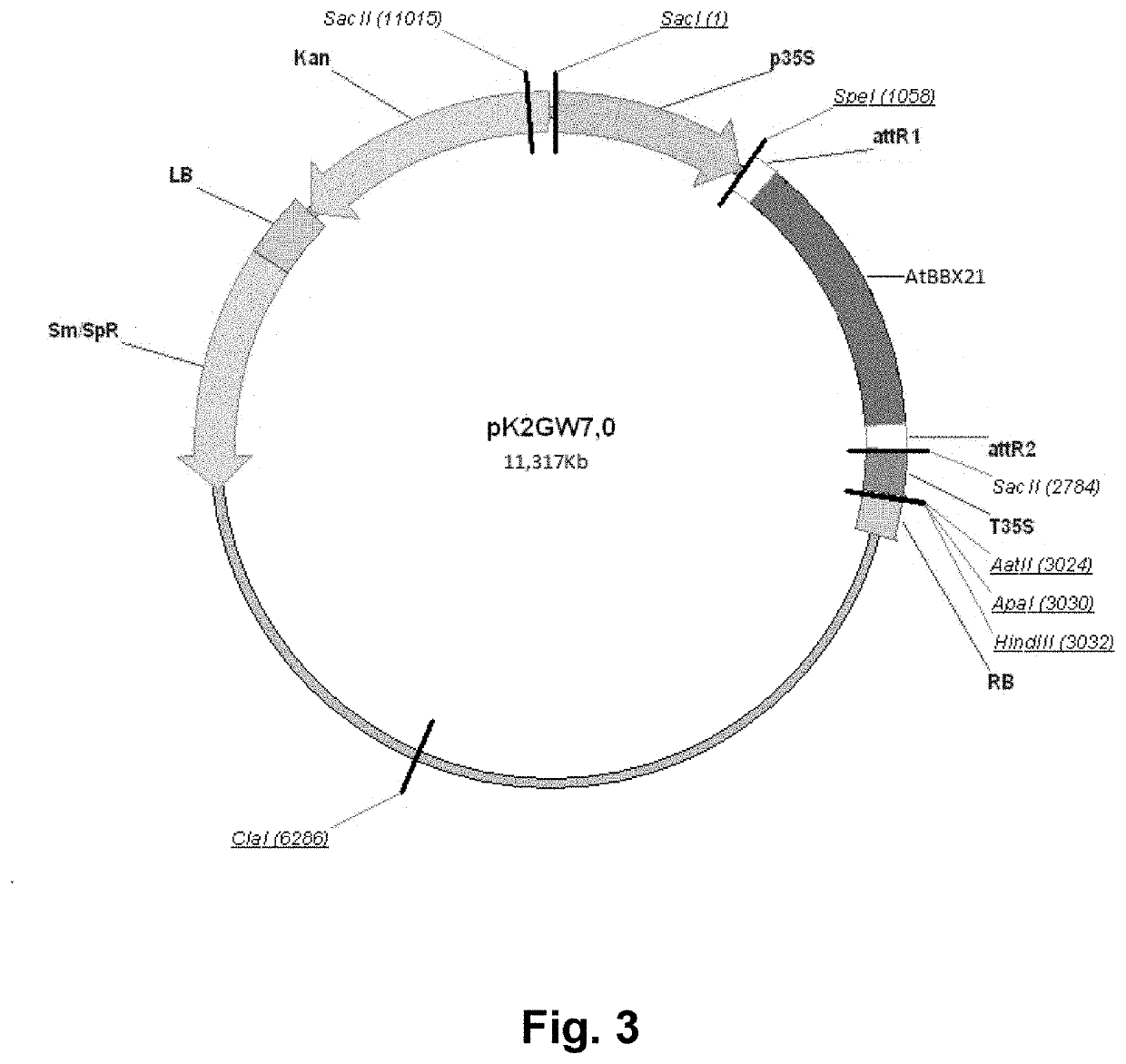Polynucleotide construct for improving agricultural characteristics in crop plants
a technology of polynucleotide constructs and crop plants, applied in the field of gene engineering and obtaining transgenic traits, can solve the problems of poorly understood agronomic species and its importance in adult plant developmen
- Summary
- Abstract
- Description
- Claims
- Application Information
AI Technical Summary
Benefits of technology
Problems solved by technology
Method used
Image
Examples
example 1
[0063]Obtaining Genomic DNA from Plants and Cloning Protocol for the X21 Event
[0064]Young (21-day old) leaf tissue samples from Arabidopsis thaliana plants of the Columbia ecotype (Col) were used for this cloning technique. DNA extraction was carried out as follows:[0065]1. Freshly cut green material is ground with liquid N2.[0066]2. Pulverized plant material is placed in a 1.5 ml Eppendorf tube and resuspended with 750 μl CTAB buffer (2×), (2% CTAB, 100 mM Tris base pH 8.0, 10 mM EDTA and 0.7M NAC1, and adding water up to 500 ml and autoclave). Then, 30 μl of 2-13 mercaptoethanol are added. The mixture is stirred gently and incubated for 30 minutes at 65° C.[0067]3. 300 μl potassium acetate (3M, pH 4.8) are added, slightly mixed and incubated on ice for 15 min. The mixture is centrifuged for 10 min at 14,000 rpm and then the supernatant is transferred to a new, clean Eppendorf tube.[0068]4. 500 μl of a mixture of chloroform: isoamylic alcohol (24:1) are added, gently mixed by inver...
example 2
[0088]Heterologous Expression of AtBBX21 in Potato Plants
[0089]Full-length BBX21 was expressed under the control of a 35S promoter in S. tuberosum var. Spunta. Transgenic potato plants were generated successfully by Agrobacterium tumefaciens-mediated transformation. 13 independent transgenic lines were obtained. To confirm the presence of BBX21 in transgenic potato plants, reverse transcription quantitative PCR (RT-qPCR) analysis was conducted for assessing the expression of BBX21 gene. RT-qPCR analysis was performed on an optical 96-well plate using SYBR Green PCR master mix (Applied Biosystems) and an ABI PRISM 7500 real-time PCR system (Applied Biosystems). Gene-specific primer pairs were designed using Beacon Designer 7.0 (Premier Biosoft). The primers used in this work are those mentioned in Example 1. The expression of each gene was normalized to tubulin (TUB) and each treatment was standardized to wild-type expression (see Table 2 below):
TABLE 2Tubulin gene, standard referenc...
example 3
[0095]Study of Photosynthesis in AtBBX21-Expressing Plants
[0096]The present inventors speculated that the higher levels of chlorophyll detected in transgenic plants (FIG. 10a) may reflect improved photosynthesis. So, the net photosynthetic rate and related photosynthetic traits in 28-d-old plants was measured.
[0097]For this experiment, measurements were carried out in an open infrared gas analysis system (Li-Cor 6400). Light functions were measured at 0, 30, 50, 100, 200, 300, 400, 500, 750, 1,000, 1,500, and 2,000 mmol m22 s21. Photosynthetic photon flux density (PPFD) was done in fully expanded leaves using the 6400-02B LED light source chamber. Air flow and CO2 concentration in the reference cell (CO2R) were automatically controlled by the equipment at 300 mmol s21 and 400 mmol s21 (ppm), respectively. Water use efficiency was estimated as the ratio of carbon assimilation and transpiration (net photosynthesis rate / transpiration rate).
[0098]It was found that transgenic lines had h...
PUM
| Property | Measurement | Unit |
|---|---|---|
| temperatures | aaaaa | aaaaa |
| temperatures | aaaaa | aaaaa |
| pH | aaaaa | aaaaa |
Abstract
Description
Claims
Application Information
 Login to View More
Login to View More - R&D
- Intellectual Property
- Life Sciences
- Materials
- Tech Scout
- Unparalleled Data Quality
- Higher Quality Content
- 60% Fewer Hallucinations
Browse by: Latest US Patents, China's latest patents, Technical Efficacy Thesaurus, Application Domain, Technology Topic, Popular Technical Reports.
© 2025 PatSnap. All rights reserved.Legal|Privacy policy|Modern Slavery Act Transparency Statement|Sitemap|About US| Contact US: help@patsnap.com



